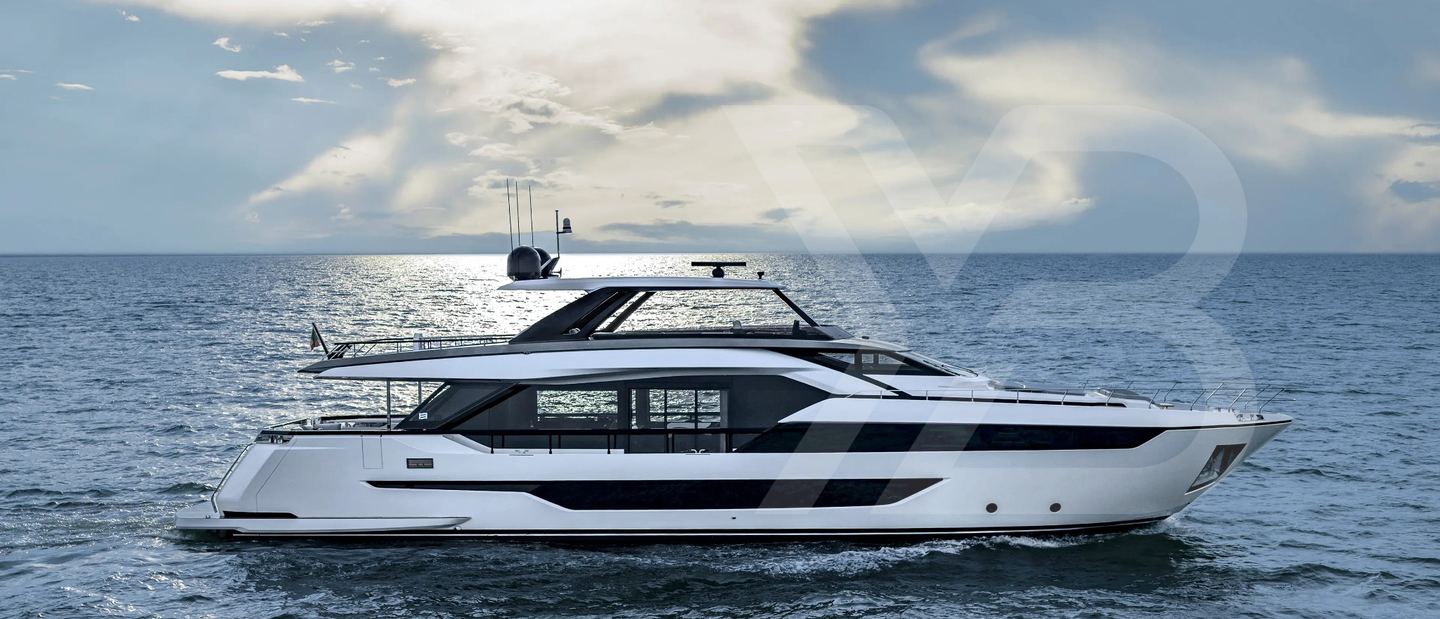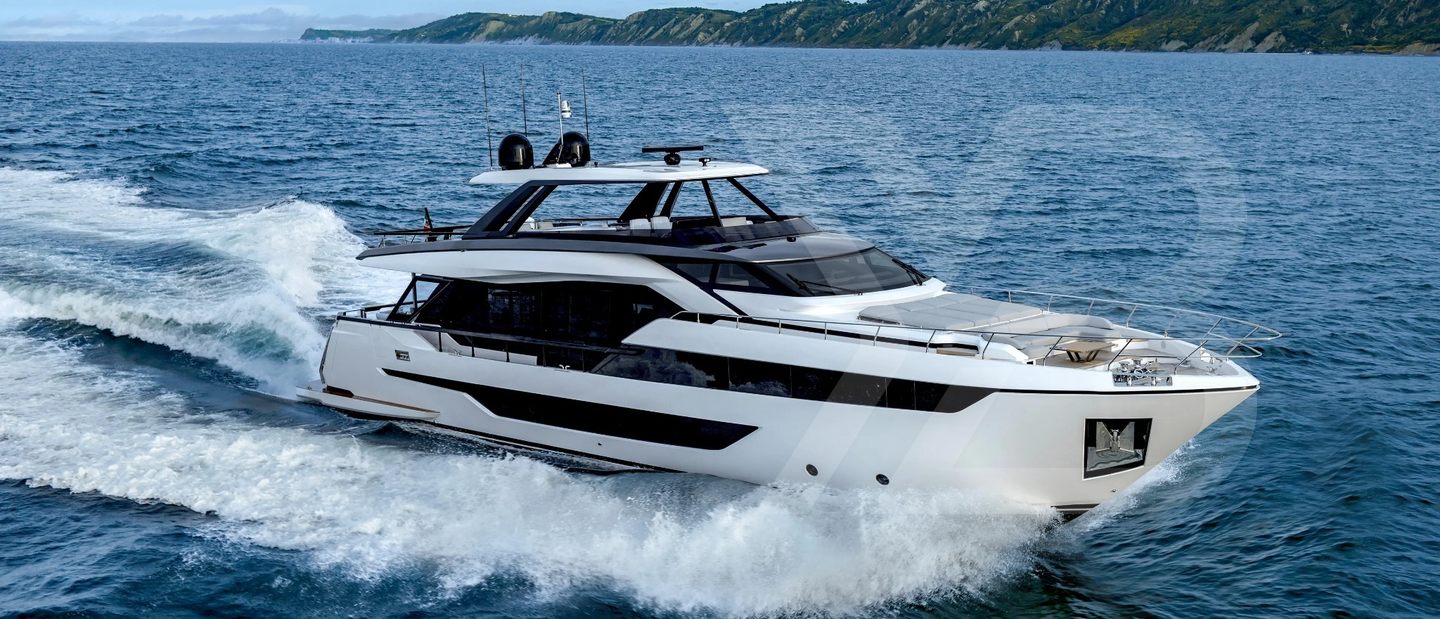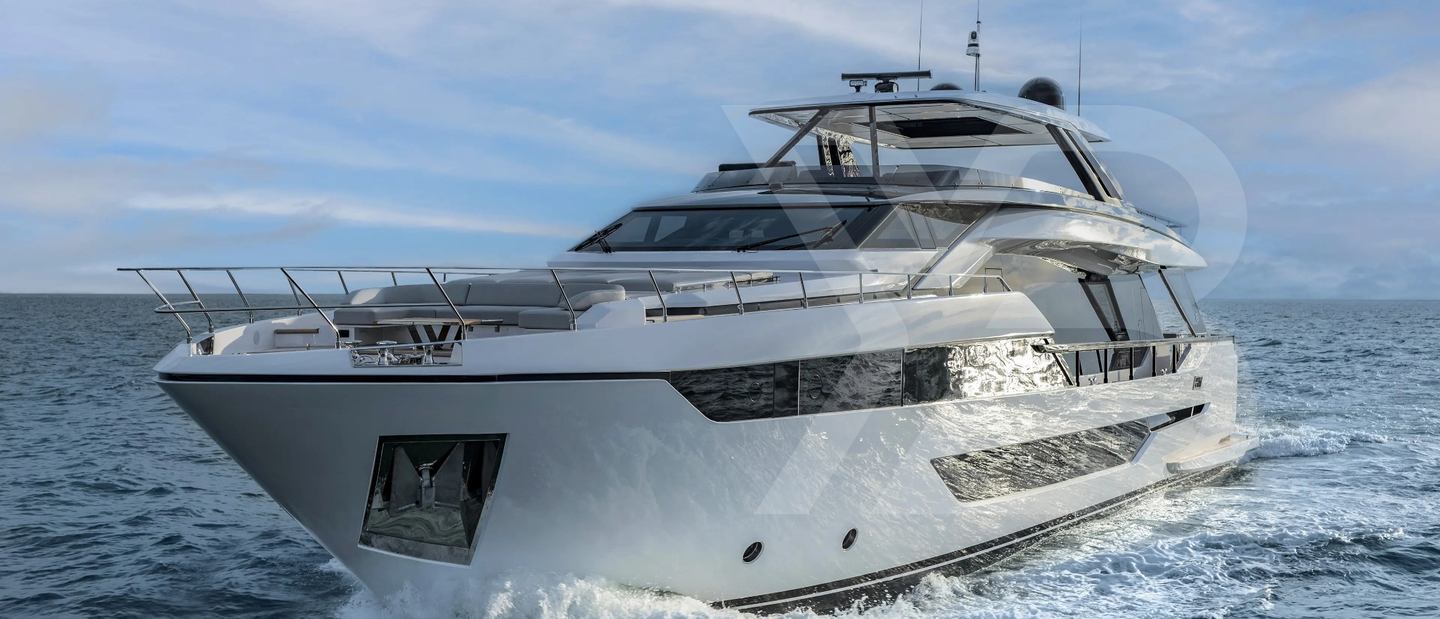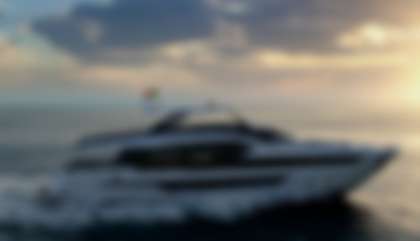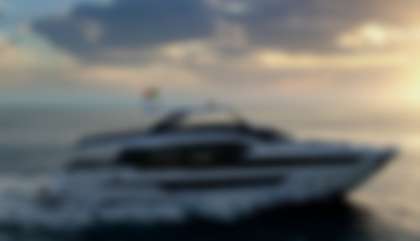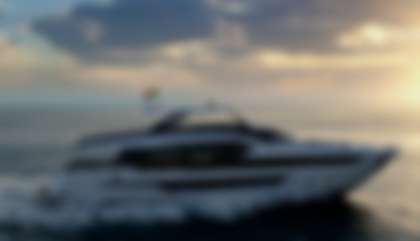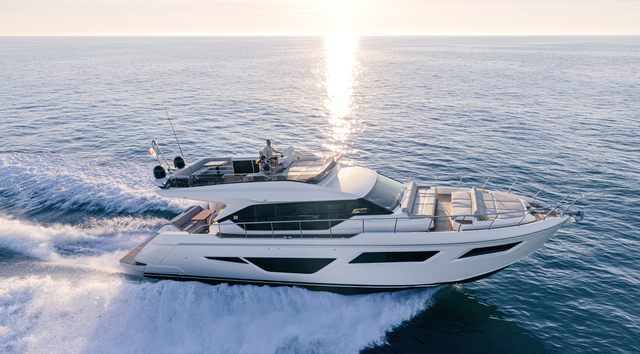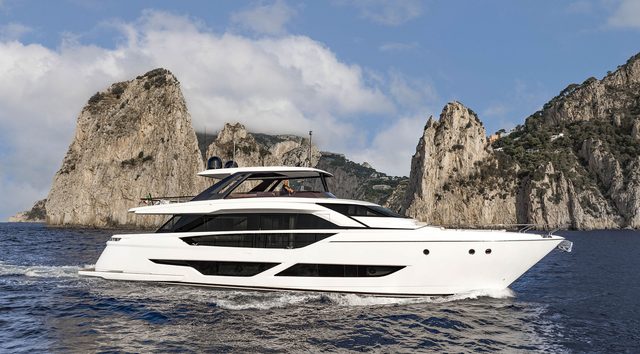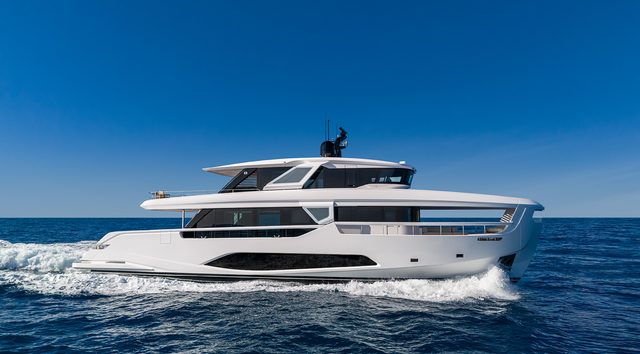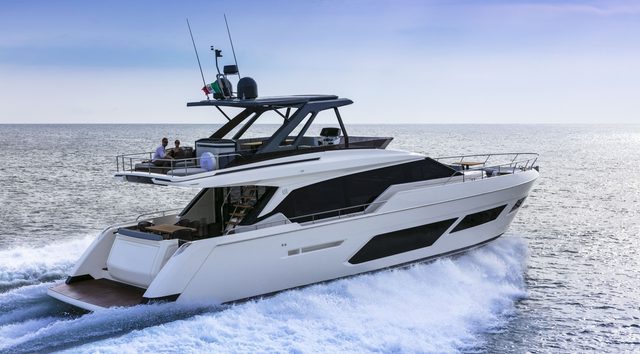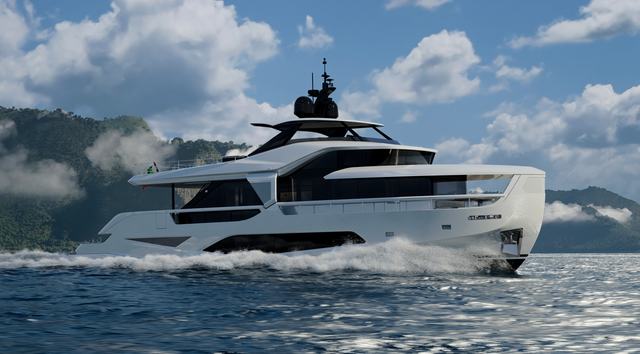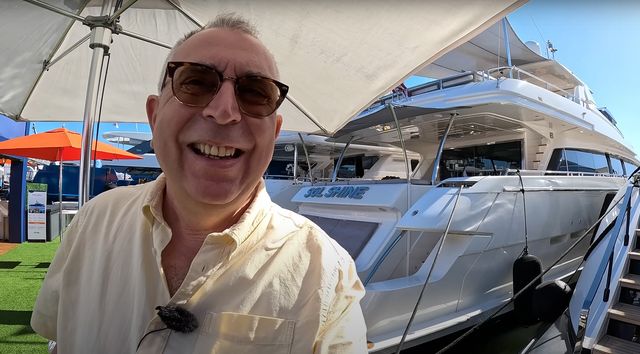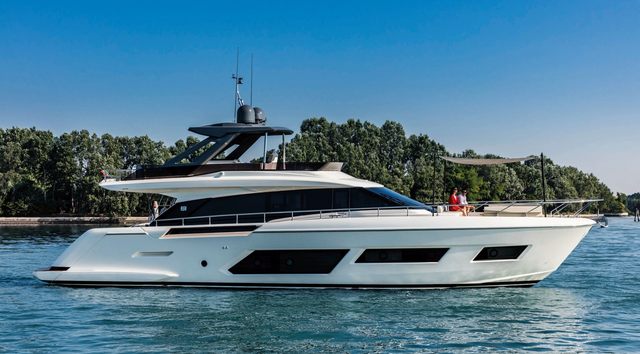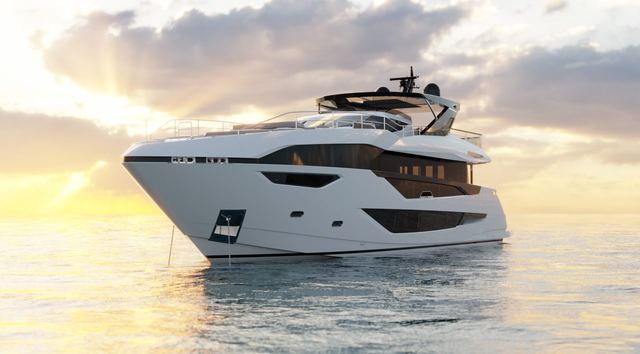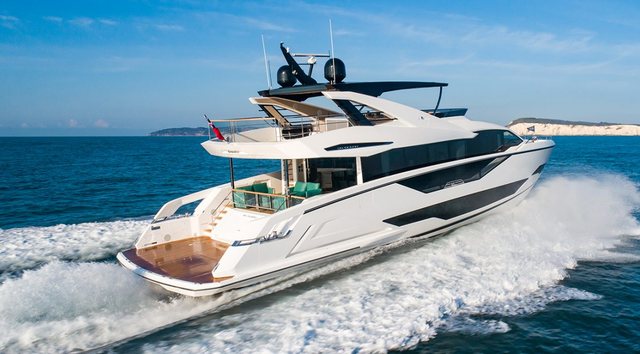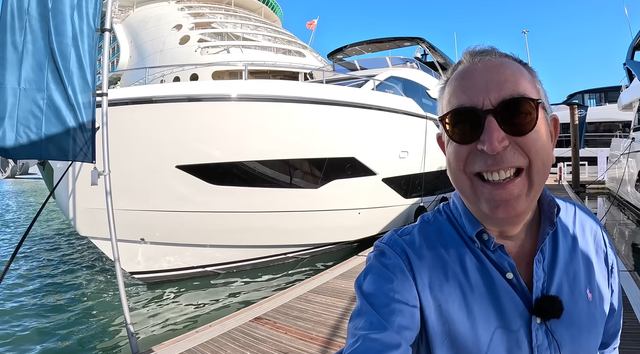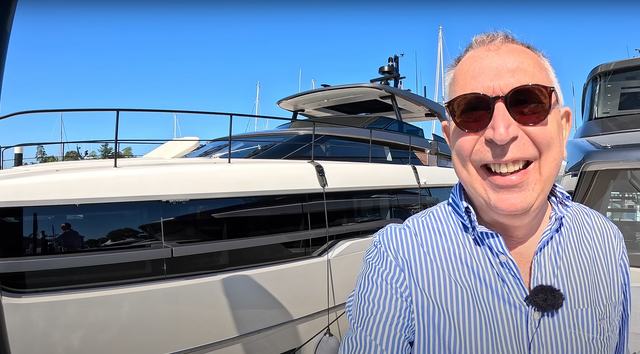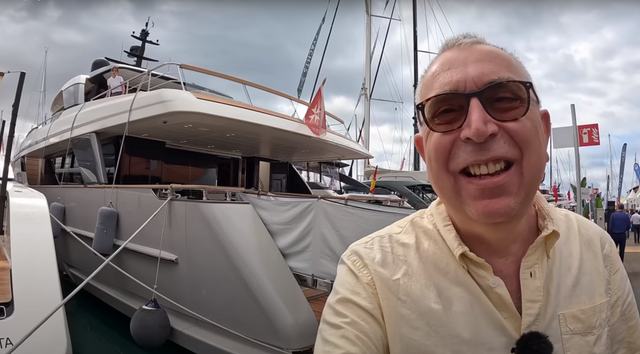Slotting just below the flagship Ferretti 1000, and replacing the 920, the 940 is now the second-largest model in the range.
At 29 meters in length, it brings a wide-body layout, raised pilothouse design, and flexible deck spaces to the table, paired with MAN V12 engines offering up to 2,200hp. This review will take a detailed look at every area of the yacht.
Ferretti 940 Key Facts

- LOA 28.97m
- Model Year 2025
- Cabins 4
- Crew 3
- Max Speed 25 knots
- Status In Production
- Yacht Type Superyacht
- Use Type Cruising
The Ferretti 940 brings the widebody layout into the sub-30-meter bracket, reworking the main deck to take full advantage of its 6.78m (22ft 3in) beam. At 28.97m (95ft 1in), it sits just beneath the flagship Ferretti 1000, but introduces several structural changes and design refinements that move the model on from the Ferretti 920 it replaces.
The hull is slightly longer than the 920’s, and the interior steps up to a full five-cabin layout as standard, with the owner’s suite forward on the main deck. Large saloon windows now stretch floor to ceiling, while the glazed aft bulwark strengthens the sense of openness at the stern. Other updates include a single-piece windscreen at the raised pilot house, reworked side-deck access around the widebody structure, and standard freestanding furniture on the aft deck.
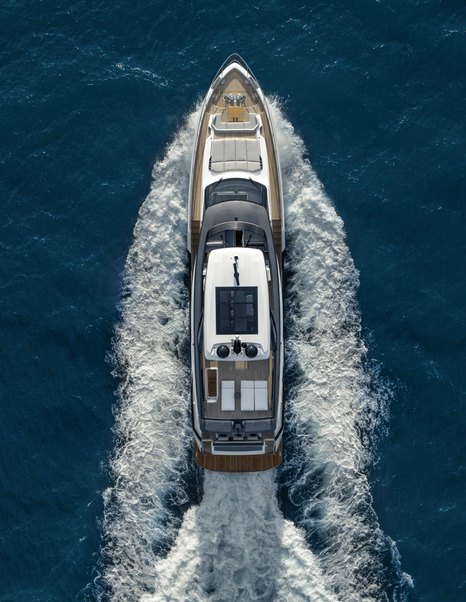
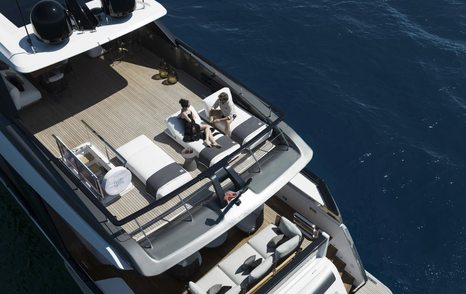
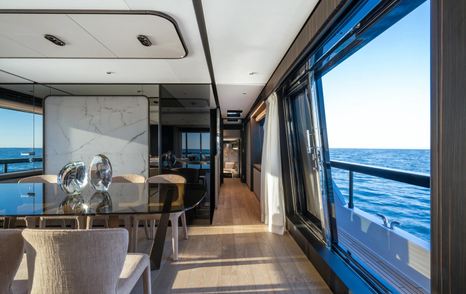
Power comes from a pair of MAN V12s in either 2000 or 2200hp format, replacing the 920's MTU setup. The first hull runs the 2000s, delivering a top speed of 25 knots and a cruising speed of 21 knots. Range remains on par with the 920, but with smoother engineering access and the option for Sleipner fins for static and in-motion stabilisation.
The model was developed by Ferretti Group’s Engineering Department with input from the Strategic Product Committee, chaired by Piero Ferrari. Filippo Salvetti handled the exterior styling, while Ideaeitalia shaped the interior with a focus on clean lines, technical refinement, and stronger continuity between indoor and outdoor spaces. The hull remains composite, but the 940’s revised proportions and updated layout give it a more contemporary stance.
Several elements draw a clear link to the 1000 - most notably the glass transom in the cockpit, stepped foredeck, and the fully integrated flybridge structure, which includes a standard hardtop. Inside, the saloon benefits from more glazing and a fresh, pared-back aesthetic. Circulation across the decks has also improved, with better separation between guest and crew areas.

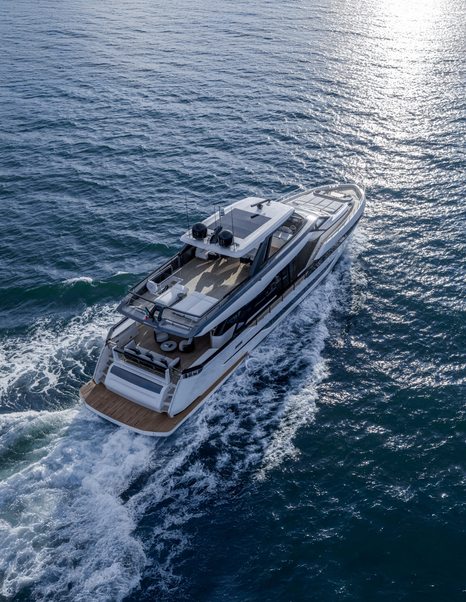
In the main saloon, immediately to port, an ice maker and a wine fridge are set between ruched panelling, while to starboard, glass storage for stemware sits just above the pop-out TV, which emerges from its locker directly opposite the L-shaped sofa. It's a well-executed arrangement seen on other yachts too - Sanlorenzo uses something similar, placing the screen in the best position for viewing from the port-side lounge.
Behind the sofa, there’s deep storage, useful for stowing away valuables before getting underway. Opposite, a clean-lined console offers additional storage without interrupting the layout. Amidships, there's a dining table arranged for ten, directly across from a sliding door on the starboard side. It's a familiar feature on boats of this size, but one that still makes a difference, for direct deck access and natural ventilation without needing to open the aft doors.
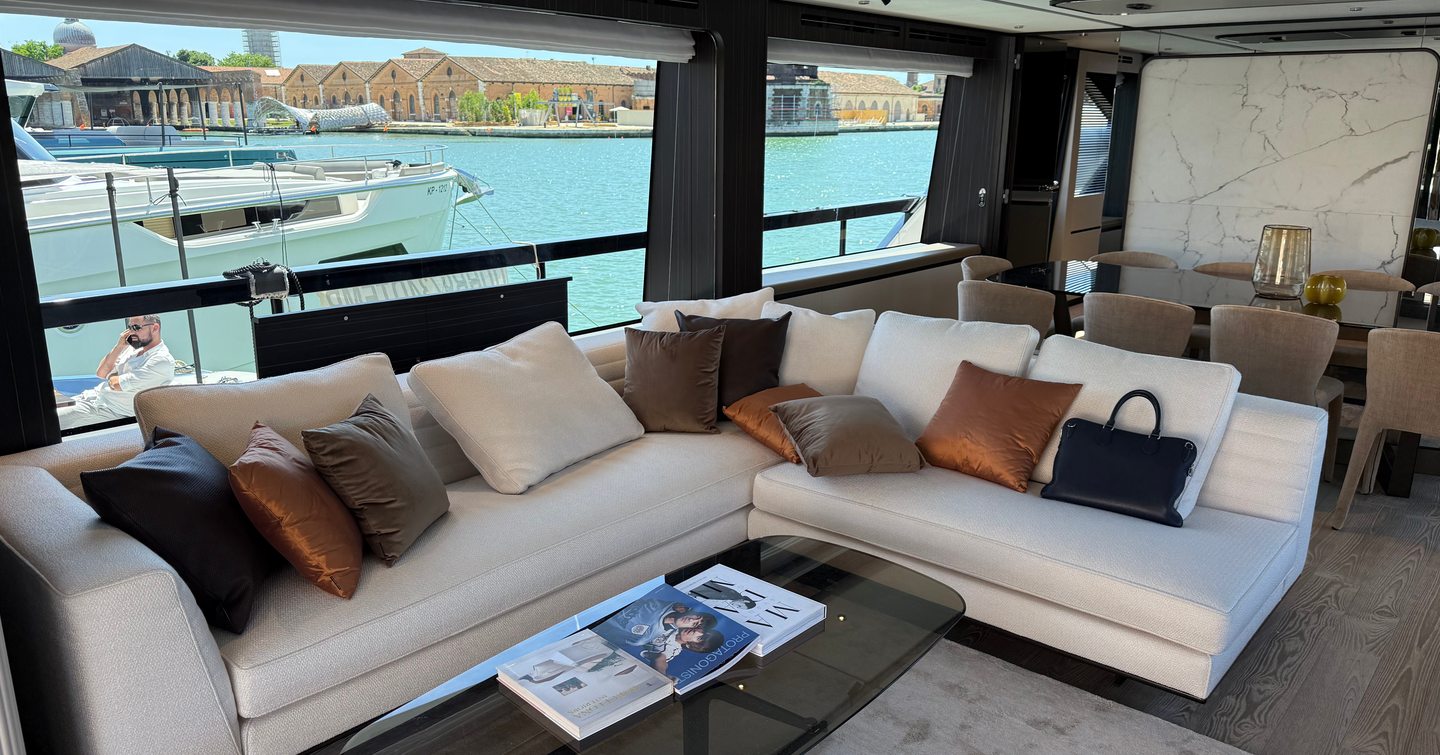
Storage is thoughtfully positioned around the dining area, too, giving the crew quick access to tableware and settings. The saloon links directly to the galley, located on the main deck port side. That connection can be closed off for privacy, though there’s also a discreet side door to the port deck, so service can run smoothly without disturbing guests.
The galley itself is small but smartly laid out, with full-size equipment including a wide oven and large induction hob. Despite its footprint, it feels well-specified - more like an extension of the guest space than a pure working zone. Storage is mostly concealed, and a dishwasher is built in. There are windows, but they look inward, so while the space is bright, the view isn’t exactly scenic.
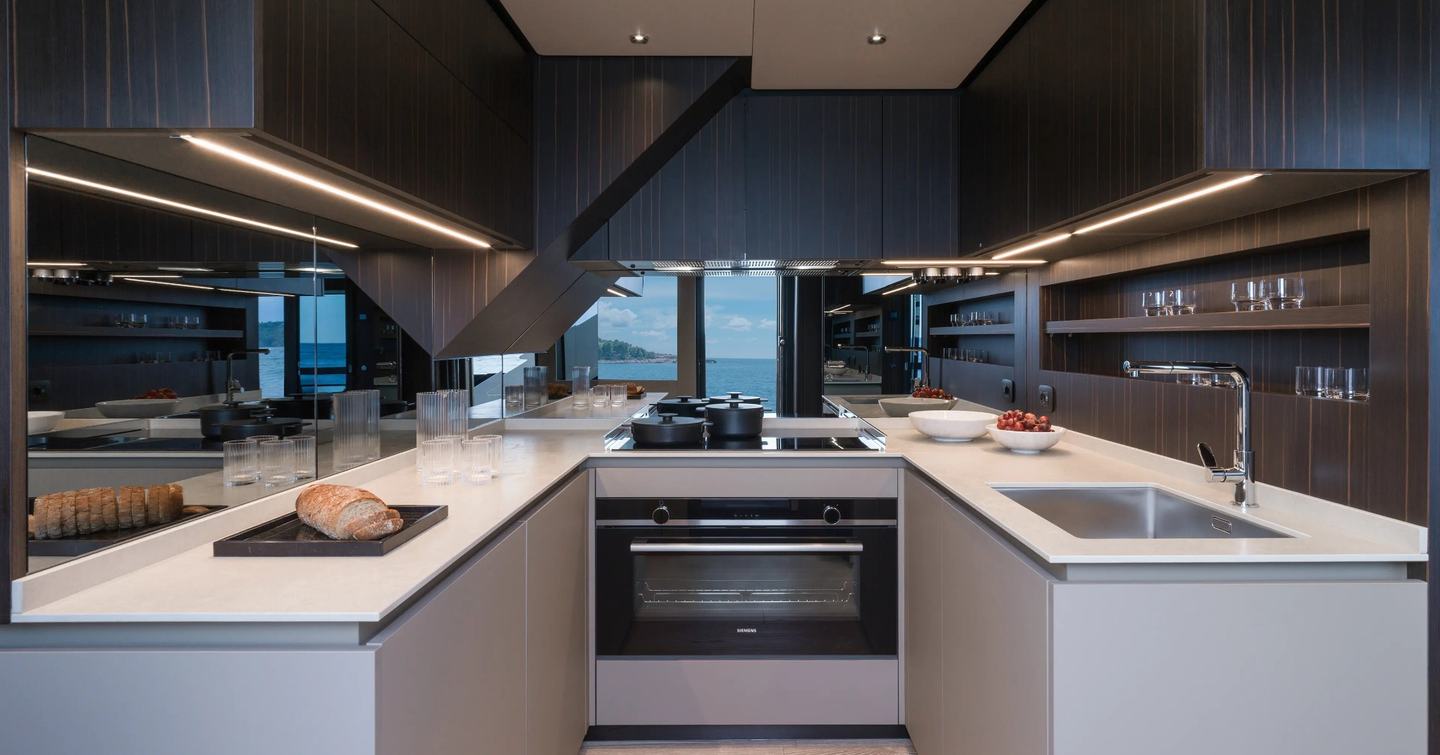
Owner's Cabin
With access to the starboard side of the main deck, the owner's cabin on the Ferretti 940 sits just beyond a day head positioned inboard for guest use. A few steps down lead past some built-in storage and into a walk-in wardrobe. It’s not huge for a yacht of this length, but it does the trick.
The main cabin has a centrally positioned bed, a small bureau to one side, and a sofa along the bulkhead. Glazing is much smaller than on some rivals in this segment, and while this is technically a main deck master, the sense of height and light isn’t quite as pronounced. But what the 940 does well here is the atmosphere. The styling is sharp, with deep walnut tones, striking marble accents, and a full-width mirror opposite the bed that adds a sense of polish.
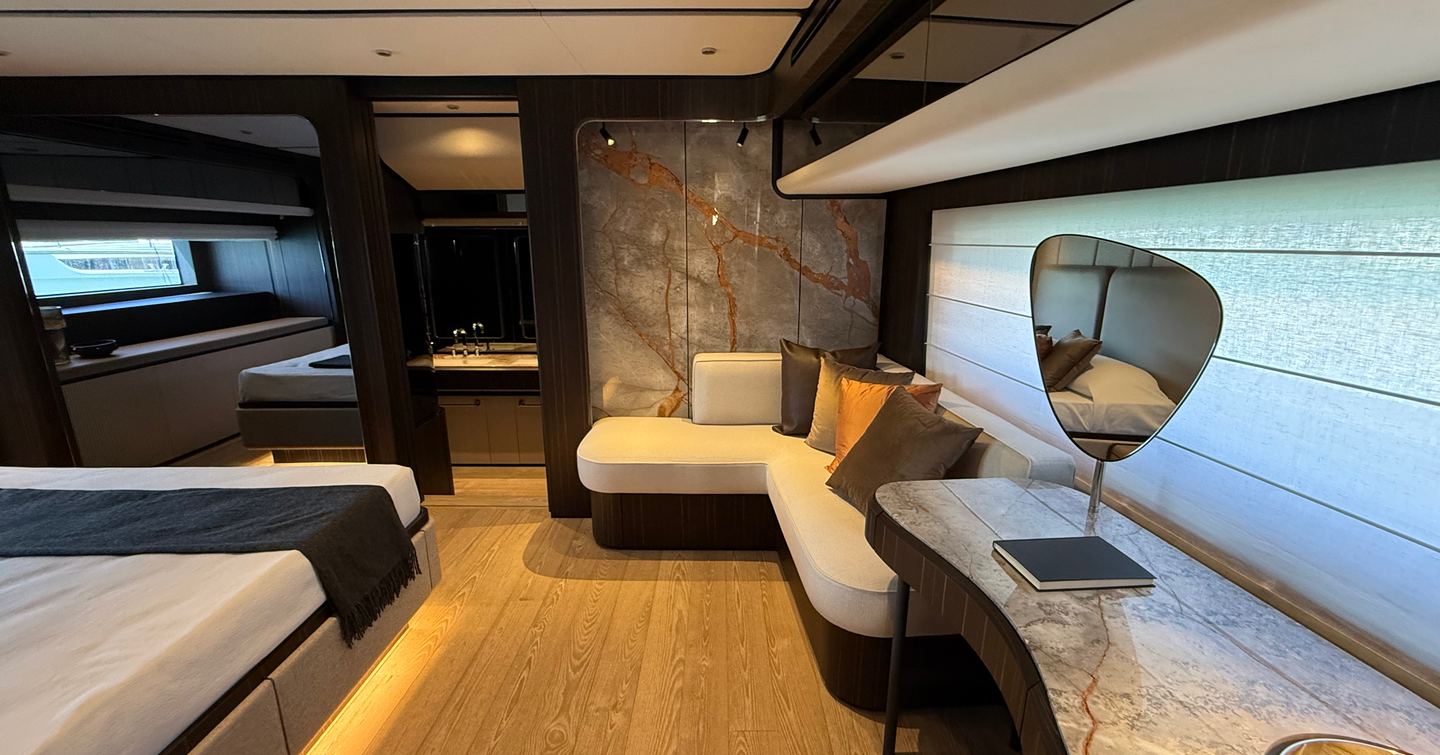

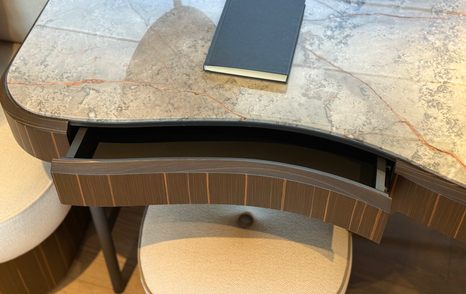
Forward, the ensuite bathroom follows a more traditional layout, but it’s visually cohesive with the rest of the interior, but a bit on the darker side.
The owner’s cabin is a stylish space with good volume, but doesn't use glass as well as its rivals and feels more compact because of it.
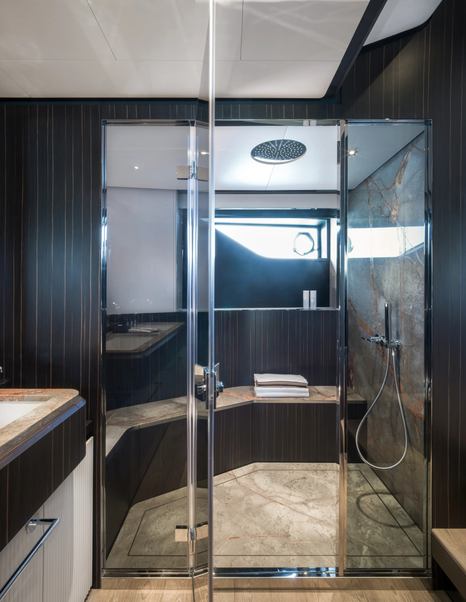
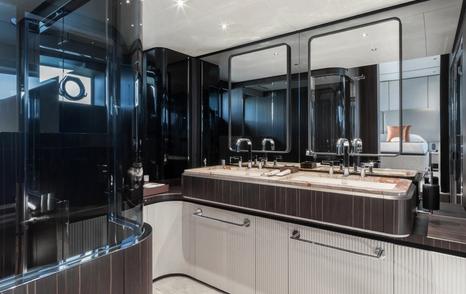
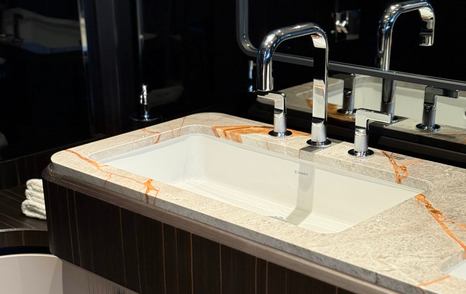
Guest Accommodation
The lower deck of the Ferretti 940 is arranged around a central lobby, finished with a marble-effect surround and a small storage unit. Cabinetry is clad in dark teak-style veneer with leather-fronted panels - a rich finish that continues across the entire guest area.
The layout is a four-cabin including a twin and three doubles. Forward to port is a twin that has adult-sized berths, so it shouldn't be a squeeze. Each berth has private AV and air conditioning controls, and a TV mounted at the foot of one of the beds. The ensuite has a marble-effect sink top, a rain shower, and a curved cubicle door that adds a bit of character.
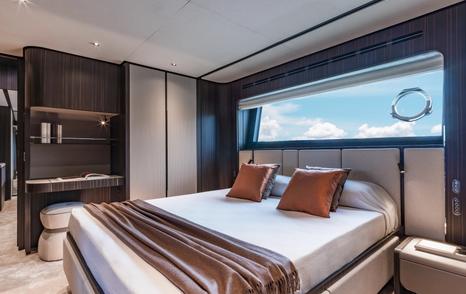
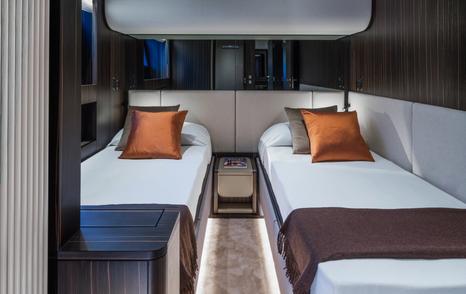
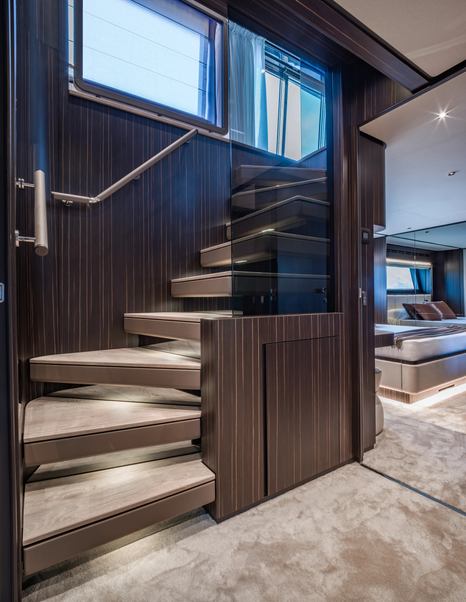
Directly opposite, on the starboard side, is the forward double. It’s a good size, with a fully walk-around bed and the same neat detailing - the TV is mounted within the mirror, and there’s a full-height hanging locker, plus deep drawers beneath the mirror. The bathroom mirrors that of the twin: same curved glass, same crisp marble, same sense of understated style. The darker woodwork here has a distinctive pinstripe finish, with light lines running through - not typical of Ferretti, but it works well and brings a slightly art deco flavour.
Amidships are a pair of larger VIP cabins, one on each side. These are a step up in both footprint and volume, with bigger beds, more floor space, and larger bathrooms. The showers here lose the curved doors but gain in simplicity - the extra room allows for a clean-lined setup, still with rain heads in the ceiling. Hull windows bring in good light, and opening ports offer natural ventilation. Each VIP gets a bureau, double wardrobes, and, aside from the twin, the same mirrored TV setup.
Crew Accommodation
The galley links directly down to the crew quarters, which are set forward. There’s a small mess area with seating for two, along with a secondary hob and a fridge. While the crew is well connected to the main galley, these extra facilities mean they can handle some light cooking and remain reasonably self-sufficient on this level.
It’s compact but functional. There’s no TV fitted in the mess on this particular boat, though that could be an option. Accommodation consists of two bunk cabins, each with its own ensuite, allowing for a crew of four with a reasonable level of privacy.
Positioned to starboard in classic Ferretti fashion, the upper helm station on the 940 has a fixed helm with minimal adjustment, but visibility is strong and the bow feels reassuringly close. Integrated cameras feed into the Simrad MFDs to give a clear view aft, helping to compensate for the lack of direct sightlines.
The system is nicely specced, with customisable displays and navigation aids. Throttle control is paired with proportional bow and stern thrusters, and the model does support Ferretti’s XENTA-assisted system. That links shafts and thrusters for joystick-style manoeuvring, offering IPS-like precision on a shaft-drive layout.

The hard top above is substantial, braced by forward struts. These do cut into the eyeline, but not enough to create a blind spot. It’s more a case of awareness than obstruction. Also, one of the benefits of the raised pilot house configuration is how naturally this external helm connects to the interior setup just a few steps below.
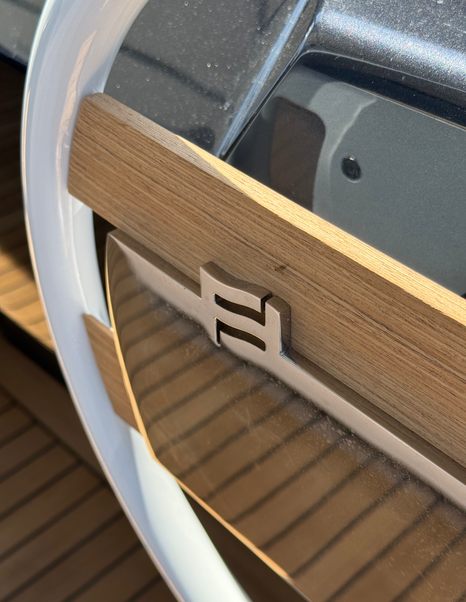
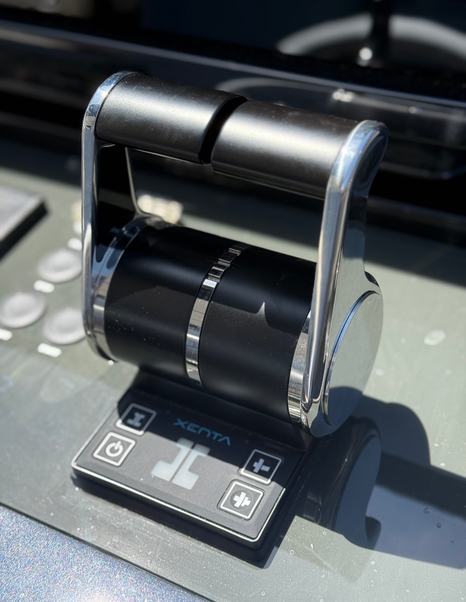
Raised Pilot House
Inside the raised pilot house, a small L-shaped sofa sits behind the helm, giving crew or guests a spot to settle in alongside the skipper during passages. The helm itself is fronted by a single-piece windscreen. Vision from raised pilot houses can sometimes feel restricted, but that’s not the case here. Even from the seated driving position, the view beneath the brow is uninterrupted. The Simrad displays are set low enough to avoid blocking forward sightlines and still offer a full-width triple-screen layout.
This is the main driving position, with a flatter dashboard and more immersive setup than the secondary station above. The screens can be configured to suit, and the captain’s chair is adjustable.
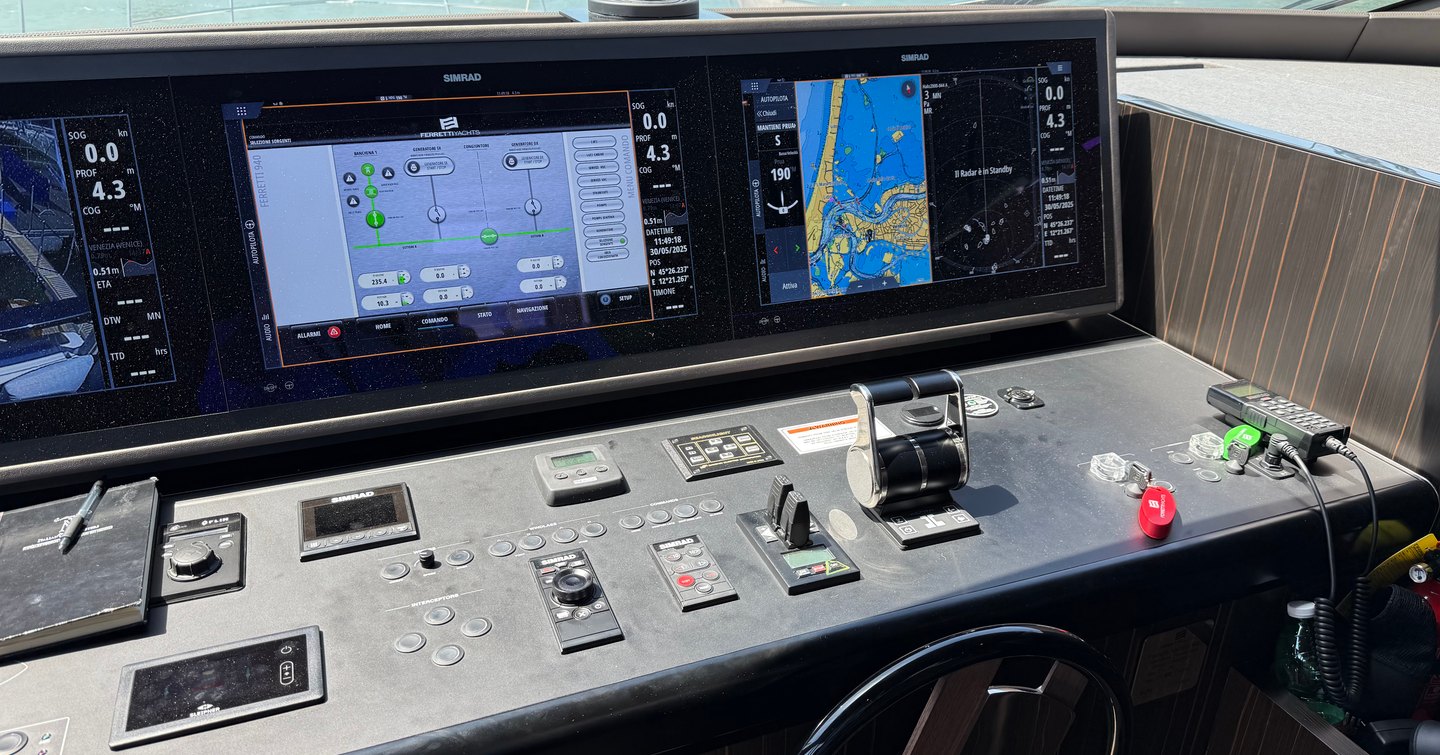
At the stern, the 940 picks up a few visual and functional cues from the larger Ferretti 1000, most notably the glass transom. That design element transforms the aft cockpit into a sleek terrace over the water. The tender garage accommodates a 4 metre (13ft 1in) tender as standard.
Launch and recovery are handled via a drop-down hydraulic platform and a partial flooding garage. The transom section opens wide, with the platform dipping into the water to create a launch zone at the stern. There’s also a starboard-side passerelle for easier boarding when moored stern-to.

In the cockpit, a glass aft bulwark keeps the connection to the sea open, with freestanding furniture underneath the flybridge overhang. A fixed dining table is available as an alternative, but in this configuration, it’s a relaxed, shaded lounging space. Mooring gear is neatly hidden under hinged lids on both sides - a typical Ferretti approach that keeps the space looking clean when the boat is not tied up.
There are boarding gates port and starboard, making it easy to step aboard from a higher quay. The footprint here is generous, giving loads of room for loose furniture and moving around. To starboard, there’s an aft wing station with engine throttles and a bow and stern thruster repeater, giving a clear line of sight across the bathing platform and up the starboard side deck.
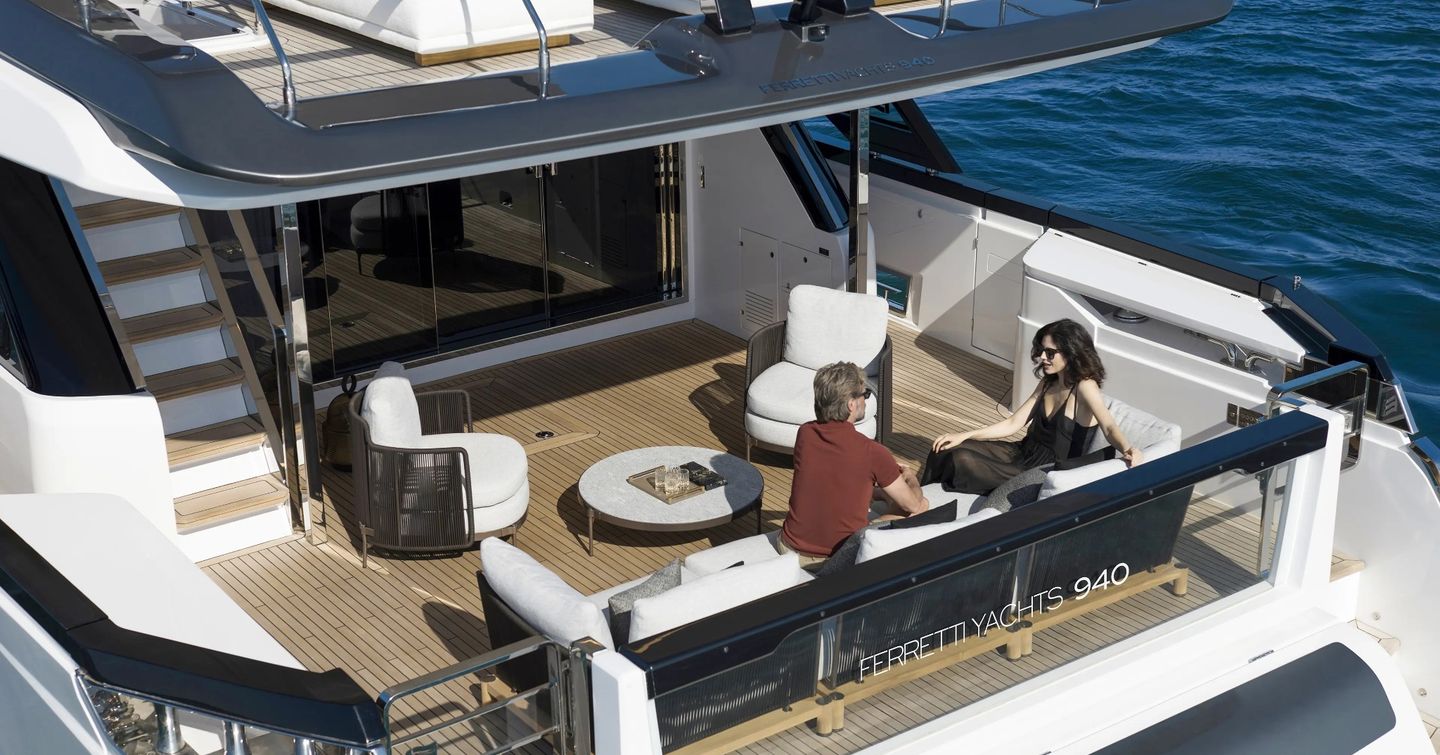
Side Decks & Foredeck
The side decks are partially covered, with those signature styling lines made up of large panes of glass that taper over the topsides. They provide a clean sweep of coverage down the walkways, while thick bulwarks add to the sense of security underway. These bulwarks are open in sections on both sides, which brings a welcome visual connection from the saloon to the sea. That openness, paired with the sheer scale of the windows, is a key part of the 940’s identity.
There’s a shift in styling here too, with the deep, uninterrupted window lines offering something a little different to the rest of the Ferretti Yachts range - more reminiscent of AB Yachts in the way they stretch vertically and frame the seating areas inside. The starboard side also features sliding glass doors into the saloon, giving direct access out onto the side deck.
From there, a short run of steps leads forward, picking up a set of guardrails as the foredeck comes into view. Down the port side, the side decks are just as generous, and the layout mirrors that of starboard. With the extra stowage forward, those lockers do double duty for gear as well as chain.
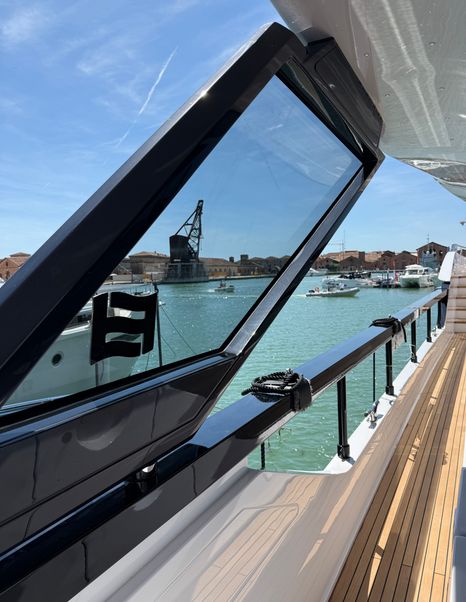

The foredeck layout flips the usual arrangement. Instead of placing the sofa tight against the windscreen, that space is now given over to a large sun pad, with the sofa pushed all the way forward into the bow. There are merits to both layouts, but having the seating right at the front puts guests right up at the sharp end when cruising slowly, always a rewarding spot to take in the view.
The deck here isn't flat, though. Moving between the sun pad and sofa involves a small step up, and there's a gentle tiered descent as you move towards the anchor handling gear. It’s something to be aware of, particularly at sea. The central table is set quite low, so it's better suited to drinks and snacks than formal meals. Shade is optional, with removable poles and canvas available to provide cover when needed.
At the very front, it’s all business. Twin windlasses, dual pairs of cleats, solid fairleads, and a clean, symmetrical arrangement give this working area a proper, engineered feel. Deep anchor lockers are built into either side of the deck, keeping the chains from each windlass completely separate to avoid tangling.
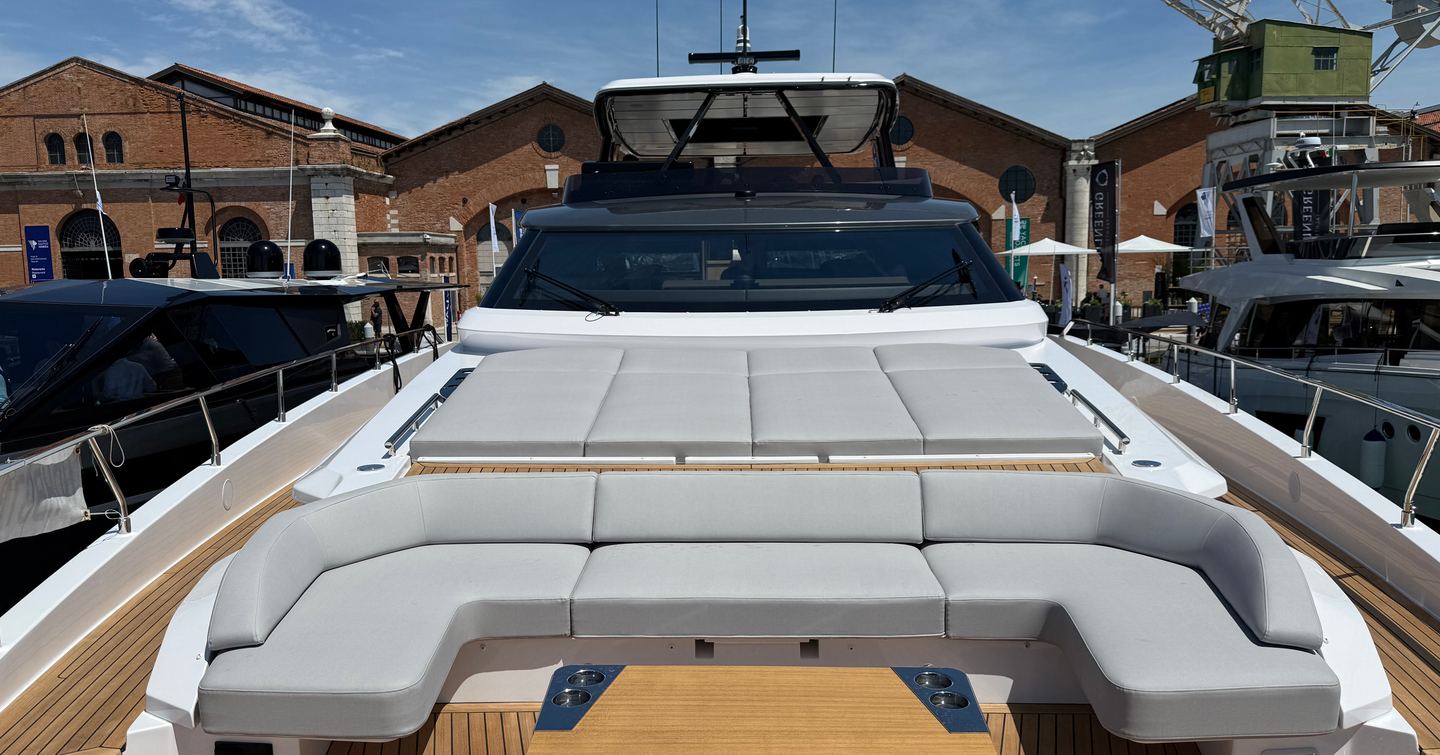
Flybridge
Accessed via a staircase to port, the flybridge on the Ferretti 940 is a very large space, and it makes full use of the yacht’s beam-forward wide-body design. As a raised pilothouse model, it connects directly with the interior helm, which keeps communication and navigation well integrated between decks.
Right aft, there’s a generous open area beneath the standard hard top. It’s laid out with loose sun loungers, but the space should lend itself well to customisation. Owners could opt for built-in furniture or a more structured lounge arrangement if preferred. Either way, it’s a good spot for sunbathing or simply stretching out under cover.
Amidships, the deck is split between a dining area and a fully equipped wet bar. Seating around the table comfortably accommodates up to 12 guests, and the central section opens to make it easier to pass through when it’s not being used for formal dining. One side is fitted with a fixed sofa, while the other is left more open with freestanding chairs, backing onto a large bar unit. The bar itself is well thought out, with a hot plate, grill, sink, and plenty of surface area to helm crew serve guests.
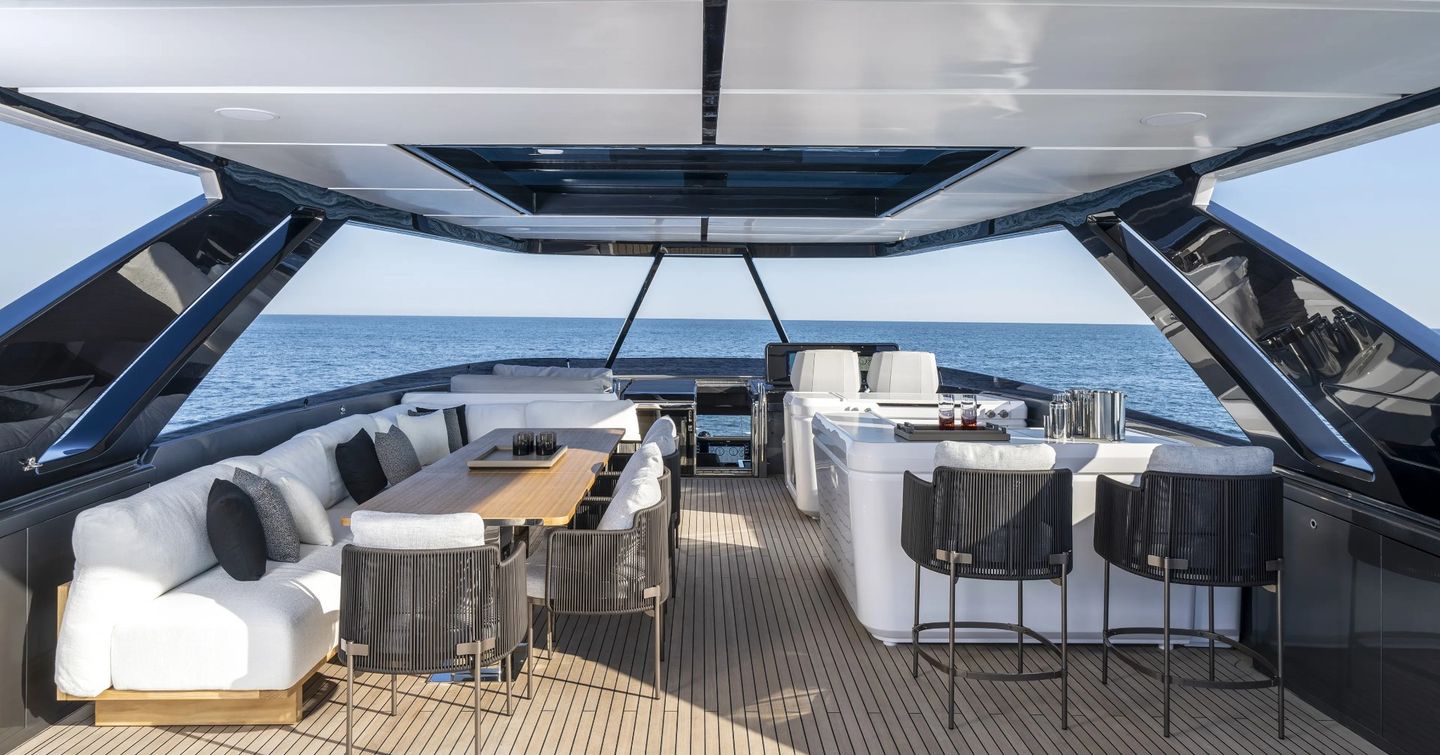
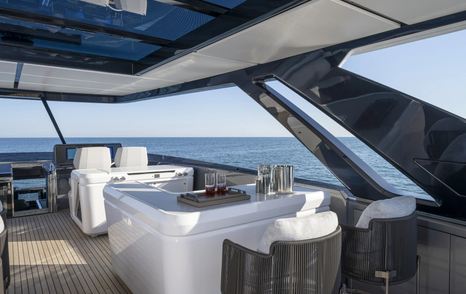
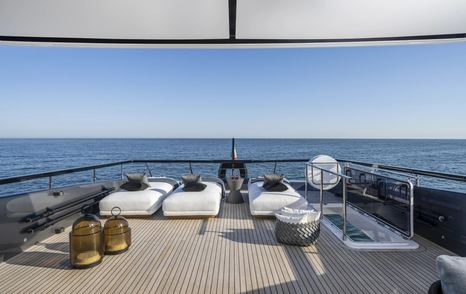
Unlike some rivals in this size range, such as the Sunseeker 100 or Princess Y95, there’s no option to fit a hot tub up here. So if that’s a priority, this might not be the right platform. But there's certainly a huge amount of usable space and scope up here.
Forward to port, there’s a more intimate dinette - a cosy nook for four opposite the helm. It’s a feature not often seen on yachts of this size and works well as a casual gathering spot. It’s the kind of place that catches the sun and feels suited to a quiet drink, a hand of cards or a chat while underway.
Two dining zones on a flybridge of this size, with distinct moods and purposes, is a thoughtful inclusion - especially when the upper helm is worked in so neatly alongside.
The engine room on the 940 is a good space for a yacht of this type. This particular example is fitted with the smaller MAN V12 2000s, rather than the 2200hp option. The headroom is shaped by the tender garage intrusion above, which creates a noticeable indentation overhead, though it doesn't compromise access to the engines.
The floor is finished in a chequer plate, making it easy to move around and inspect systems. Generators, the hydraulic pack, and the water maker are all lined up along the outboard side, where headroom is better thanks to being outside of the garage moulding.
Our Verdict
The Ferretti 940 plays to its strengths: space, comfort, and an uncomplicated layout. It’s a big, wide-bodied machine that feels substantial, with a raised pilothouse setup that links well with the upper helm on the flybridge, which itself is a real strong point with plenty of space for lounging, dining, and drinks at the bar, even if there’s no option for a hot tub.
Inside, it has neat detailing and a layout that gives crew working access without intruding on guest space. The main deck owner’s suite looks the part but could do with more glass - rivals like the Pearl 95 and Sunseeker 100 Yacht feel lighter and more connected to the sea. That said, the four-cabin lower deck is well executed, and the engine room is tidy, spacious, and built to be used.
If you're an owner looking for a comfortable long-range cruiser that doesn’t shout but quietly delivers across the board, the 940 might be the one to shortlist.
Reasons to Buy
- Wide-body increases interior space
- Connected raised pilothouse helm
- Accessible engine room
- Hydraulic platform with tender garage
Things to Consider
- Interior feels dark
- No hot tub option
- Small crew capacity
Looking to own a Ferretti 940? Use YachtBuyer’s Market Watch to compare all new and used Ferretti 940 Yachts for sale worldwide. You can also order a new Ferretti 940, customized to your exact specifications, with options for engine choice and layout configuration. Alternatively, explore our global listings of new and used yachts for sale and find your perfect yacht today!
Rivals to Consider
The Sunseeker 100 Yacht offers accommodation for up to 12 guests across five cabins, matching the Ferretti 940's guest capacity. However, it distinguishes itself with an owner's stateroom featuring a private bow terrace, providing a secluded outdoor space directly accessible from the suite. This yacht also boasts a single-level exterior deck from flybridge to foredeck, enhancing the sense of openness and flow throughout the vessel.
The Riva 90' Argo accommodates up to eight guests in four cabins, slightly fewer than the Ferretti 940. Its standout feature is its sleek, aerodynamic design, combining classic Riva styling with modern performance. The yacht's elegant lines and advanced hull design contribute to both its aesthetic appeal and seakeeping abilities.
Designed for up to 10 guests in five cabins, the Sunseeker 90 Ocean matches the Ferretti 940 in guest capacity. Its unique feature is a remarkable 20% increase in overall volume and nearly 30% more deck space compared to similar yachts, achieved through its substantial beam and upright bow design. This results in expansive living areas and enhanced comfort on board.
The Ferretti 960 offers accommodation for up to 10 guests in five cabins, similar to the 940. It sets itself apart with its main deck owner suite, a feature not commonly found in yachts of this size, providing direct access to the main living areas and panoramic views. Additionally, the 960 boasts a top speed of 31 knots, surpassing the 940's cruising speed.
Accommodating up to 10 guests in five cabins, the Ocean Alexander 28E aligns with the Ferretti 940 in guest capacity. Its distinguishing feature is its impressive gross tonnage of 163GT, offering expansive interior spaces and a sense of volume typically found in larger yachts. This makes it particularly appealing for extended cruising and liveaboard comfort.
The Princess Y95 provides accommodation for up to 10 guests in five cabins, matching the Ferretti 940. Its standout feature is its extensive range of 2,000 nautical miles, making it ideal for long-distance voyages without the need for frequent refueling. This capability enhances its appeal to owners seeking adventure.
Considering a new yacht? Explore Ferretti's entire current range to find the model that best suits your needs, and compare it with alternatives from competitors to ensure you make the perfect choice.
Specifications
- Builder Ferretti Yachts
- Range Flybridge
- Model Ferretti 940
- Length Overall 28.97m
- Beam 6.76m
- Draft 2.3m
- Hull GRP
- Cabins 4
- Berths 8
- Crew 3
- Yacht Type (Primary) Superyacht
- Use Type (Primary) Cruising
- Cruising Speed
- Max Speed
- Fuel Capacity 9,000 Litres
- Fresh Water Capacity 1,320 Litres
- Engine Model 2x MAN V12-2000
- Engine max range (speed type) 320 (nm)
Available Stock
Interested in a Ferretti 940?
NEW Build
Find your local dealer for a personalised, no-cost consultation
or just request
Brochures & Pricing
Used & In Stock
Looking for a ready-to-go Ferretti 940 or pre-owned options? Explore all inventory of the Ferretti 940 available worldwide
